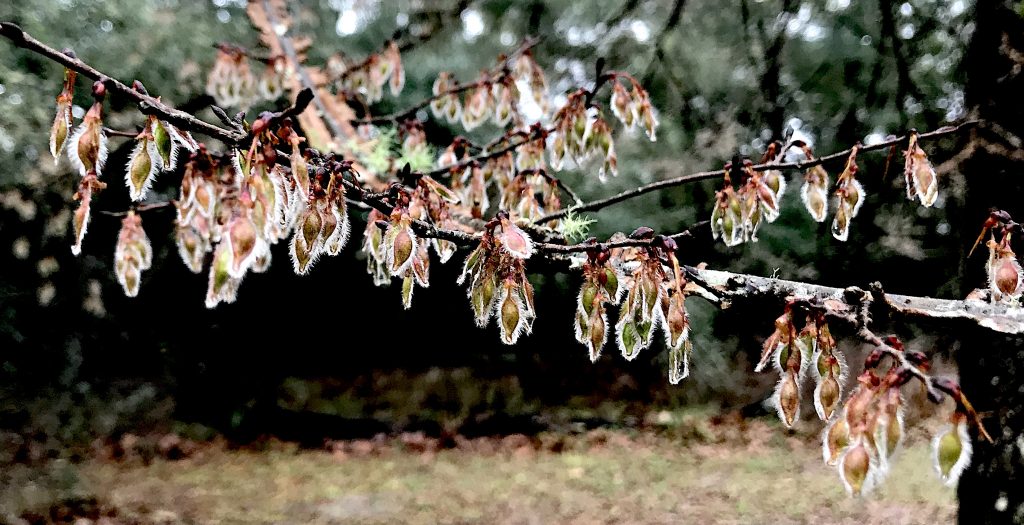
They look insubstantial but they were tender and tasty: Young Drake Elm buds. Photo by Green Deane
Young and tender describes them best: Elm leaves we nibbled during our foraging class in Gainesville Saturday. They were a mystery at first, as the trees are usually all leaves out when I visit the area. As far as I know all elm leaves are edible except one that grows in Manchuria, Ulmus propinqua. As the Dutch Elm Disease wiped out most elms in North American the most common elms now are the planted Lacebark Elm and it’s cousin the Siberian Elm. Florida’s elm also escaped the disease and can be found often in river plaines. They have calcium, manganese, iron, magnesium, phosphorus, potassium, selenium, zinc, beta-carotene, vitamin C, and some B vitamins. They also have harder things to say: D-galactose acid, D-galacturonic acid, L-rhamnose acid, Oleic acid, Palmitic acid, Polyphenols, Tannin, and oligomeric procyanidins (the latter have antiseptic and anti-allergic action.) For more information on elms go here or for a video here.
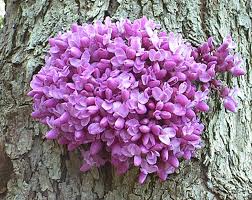
Blossoms of the Eastern Red Bud. Photo by Green Deane
Most trees in the Pea Family are toxic but not all of them. One of the edible ones is blossoming now: The Eastern Redbud. The lanky tree is very easy to spot tis time of year because it has small pink blossoms and no leaves. Those small flowers — about the size of your fingernail — are important because there’s an ornamental tree with pink flowers also blossoming now that is not edible, the Pink Tabebuia. The Pink Tabebuia, however, has large blossoms about the same size as an Azalea blossom. The Eastern Redbud provides quite a few edibles: Tiny blossoms, young leaves, and pea pods. The Pink Tabebuia, T. heterophylla, does not have edible parts nor does two of its relatives, the Yellow Tabebuia, T. chrysotricha, and the Silver Trumpet Tree, T. caraiba. However, a fourth one in Florida, T. impetiginosa, or Purple Trumpet Tree, has seen its inner bark used as an herbal tea. Among those who have sipped and liked the tea are Ghandi and Czar Nicholas II of Russia. You can read more about the Eastern Red Bud here, video here.
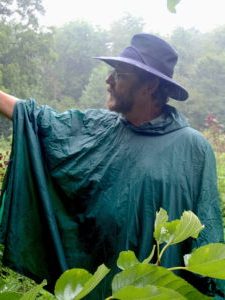
Classes are held rain or shine or cold. (Hurricanes are an exception.) Photo by Kelly Fagan.
Foraging Classes: One class this weekend in the expansive Eagle Lake Park in Largo. As it was once a working farm we find all kinds of plants to discuss.
Sunday, February 14th, Eagle Park Lake, 1800 Keene Road, Largo, FL 33771. 9 a.m. to noon. Meet at the dog park pavilion.
Sunday, February 21st, Dreher Park, 1200 Southern Blvd., West Palm Beach, 33405, 9 .a.m. to noon. Meet just north of the science center.
Saturday, March 6th, Red Bug Slough Preserve, 5200 Beneva Road, Sarasota, FL, 34233. 9 a.m. to noon.
Sunday, March 7th, Mead Gardens, 1500 S. Denning Dr., Winter Park, FL 32789. 9 a.m. to noon. The entrance is on the west side off Denning not the east side off Pennsylvania. Some GPS maps are wrong. Meet near the bathrooms.
For more information, to pre-pay or sign up, go here.
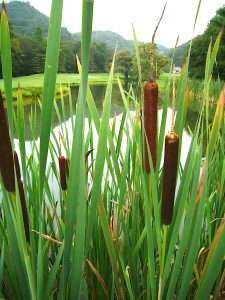
Cattails in North Carolina. Photo by Green Deane
Two other species that are “blossoming” now are familiar ones, Pines and Cattails. Males pine cones, yes there are such a thing, are dropping pollen now. Called microsporangiate strobili, they are edible but don’t have much of a flavor or pleasing texture. Their pollen, however, is edible and can have some hormonal uses as well. Interestingly pine pollen is often blamed for Hay Fever but usually it’s Ragweed that is causing allergy problems at about the same time. Pine pollen is heavy and doesn’t travel far whereas Ragweed pollen is light and floats long distances. You can read about pines here, video here. Also producing pollen powder now are Cattails. Far more productive than male pine cones, the male part of the Cattail blossom produces a dense, yellow, pollen. It’s relatively easy to collect and quite useful such as augmenting bread flour. The dry female part of the blossom — the cat tail part — is edible but is as unattractive to eat as the male pine cone. You can read more about the Cattail here, video here.
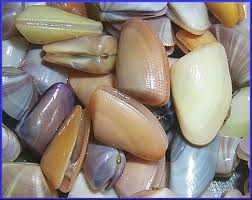
Coquina are tasty but quite small.
Sometime instead finding answers they find you. As you know there are several articles on the EatTheWeeds website that are about edibles covered by the subtitle: And other things, too. That subtitle was intentionally added when the site went up some 14 years ago. There are a lot of things in the world to eat. Before Andrew Zimmern was traipsing around the globe for the Travel Channel eating untraditional food EatTheWeeds was writing about them. As one might expect that has caused a good amount of disagreeing mail. Many people keep as pets creatures that other people eat. Thus far, however, no one has complained about Coquina, a coastal clam that’s about the size of your fingernail. The tiny clams make an absolutely delicious green broth that I like to add — I know it’s sacrilege — instant potatoes and butter to. One of the down sides is that the clams are so small getting the meat out of the shell is microscopic work. That is so frustrating as most of it is tossed away. However in Australia they figured out a commercial way of separating meat and shell. How that was done was something of a mystery until a post on the Green Deane Forum provided an answer. The cooked shells are vigorously stired. After that it is a matter of straining the shells from the meat. I’ve got to try that. You can read about Coquina here, and the crunchy Mole Crabs, here. A video on both of them is here.
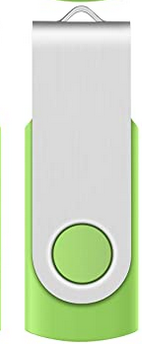
Green Deane videos are now available on a USB.
150-video USB or 135 video DVD set would be a good winter present and either is now $99. My nine-DVD set of 135 videos has been selling for seven years and are still available. They are the same videos I have on You Tube. Some people like to have a separate copy. A second option is a16-gig USB that has those 135 videos plus 15 more. While the videos can be run from the DVDs the videos on the USB have to be copied to your computer to play. They are MP4 files. The150-video USB is $99 and the 135-video DVD set is now $99. The DVDs will be sold until they run out then will be exclusively replaced by the USB. This is a change I’ve been trying to make for several years. So if you have been wanting the 135-video DVD set order it now as the price is reduced and the supply limited. Or you can order the USB. My headache is getting my WordPress Order page changed to reflect these changes. We’ve been working on it for several months. However, if you want to order now either the USB or the DVD set make a $99 “donation” using the link at the bottom of this page or here. That order form provides me with your address, the amount — $99 — tells me it is not a donation and in the note say if you want the DVD set or the USB.

Green Deane Forum
Want to identify a plant? Perhaps you’re looking for a foraging reference? You might have a UFO, an Unidentified Flowering Object, you want identified. On the Green Deane Forum we — including Green Deane and others from around the world — chat about foraging all year. And it’s not just about warm-weather plants or just North American flora. Many nations share common weeds so there’s a lot to talk. There’s also more than weeds. The reference section has information for foraging around the world. There are also articles on food preservation, and forgotten skills from making bows to fermenting food.
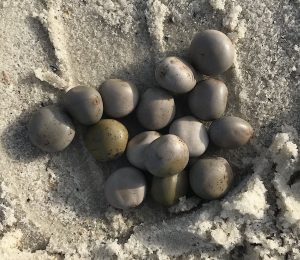
Nicker Beans are not edible. Photo by Green Deane
When I’m asked about Nicker Beans, Caesalpinia Bonducella, I say they are not edible but were used medicinally and that is outside my paygrade. I am not an hearbalist. That said I did notice an Indian article this week on them. It said the parts that were used were the roasted seeds. They were ground, made into a tea, and used to reduce malaria-caused fever like quinine (among several dozen applications.) The bark is purgative. In oil the seed powder had several external uses as well. It’s also been researched as a potential antioxidant.
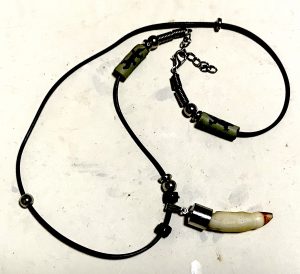
Alligator tooth pendant.
After our class last week in Port Charlotte we noticed after everyone had left an alligator tooth pendant on the picnic table. If it is yours let me know and I’ll get it back to you.
This is weekly newsletter 444, If you want to subscribe to this free newsletter you can find the sign-up form in the menu at the top of the page.
To donate to the Green Deane Newsletter click here.


I always prefer using natural to arificial products . I think it is more safe to use the male part of the cattail blossom powder dfor augmenting bread flour . I personally suffer from gluten in making bread and baking in general . Please refer to : pii<articles<www.sciencedirect.com